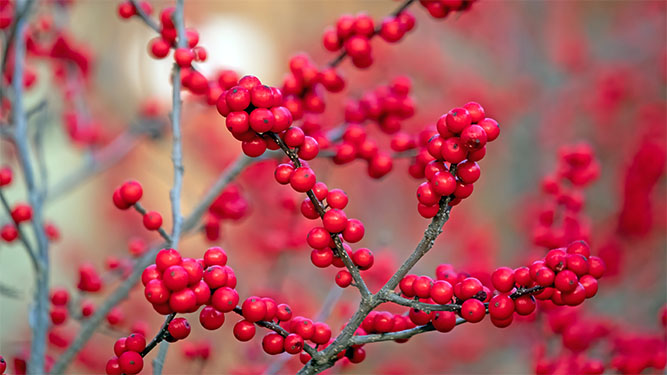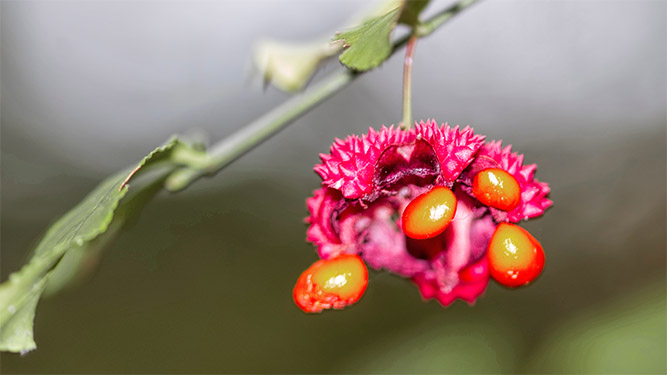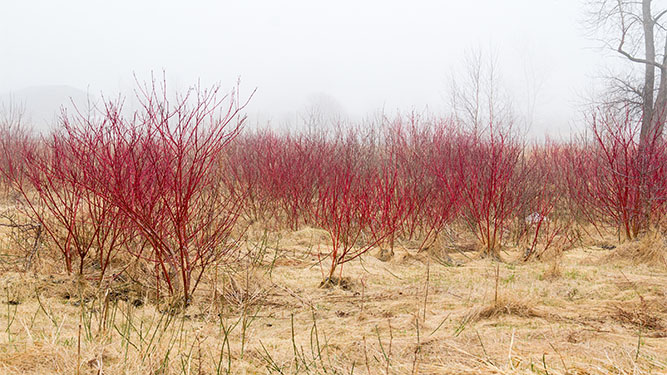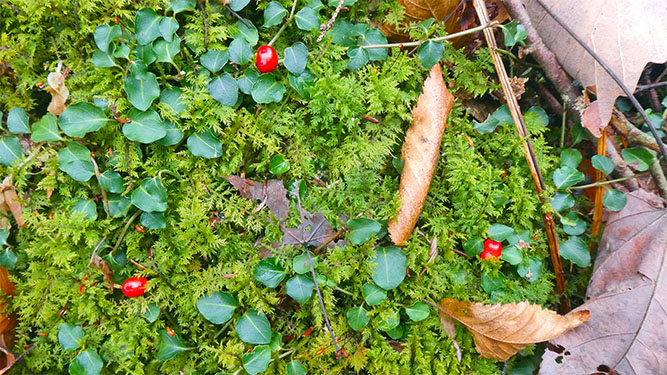This time of the year, even the woods are decked out for the holiday season!
Red is used in celebrating and decorating for winter solstice, Christmas, and Kwanzaa, and symbolizes many things.
There are many plants with red berries or stems that add a festive contrast to the neutral whites and browns of a winter woods.
American holly (Ilex opaca) is native to Pennsylvania, frequently planted, and will easily escape from cultivation.
Berries are produced on the female holly plant and can be poisonous to pets and humans if eaten in large quantities. However, birds and small animals are unaffected and will rely on these berries throughout the winter.
It’s said that burning holly with the Yule log will burn away troubles from the following year!
Image: American holly (Ilex opaca)
Native winterberry holly (Ilex verticillata) is a wetland shrub with branches covered in red berries.
Although it lacks the evergreen, spiny leaves of American holly, it is used in winter decorations and stands out in the winter landscape.
Like American holly, only the female plants produce berries, providing winter food for small mammals and up to 50 species of birds.
Image: Winterberry holly (Ilex verticillata)
Other native shrubs in the winter woods with red berries are two wahoo species, eastern wahoo (Euonymus atropurpureus) and hearts-a-bursting (Euonymus americanus), and northern spicebush (Lindera benzoin).
The dangling, red fruit capsules of the wahoo are most conspicuous after leaf drop. All parts of this plant are toxic to humans but provide food for birds and mammals.
Image: Hearts-a-bursting (Euonymus americanus)
Spicebush, another deciduous shrub found in moist woods, is very common in Pennsylvania and produces flavorful red berries that can be consumed by humans and wildlife alike.
At the woods edge, you may see the terminal clusters of fuzzy red fruit of the female staghorn sumac (Rhus typhina).
This native colonial shrub is often mistakenly considered poisonous or invasive. Its persistent clusters of red berries are a great source of food for birds.
Image: Staghorn sumac (Rhus typhina)
Red in the winter landscape also is evident in the distinct, red twigs of the native red-osier dogwood (Cornus sericea).
This wetland shrub provides resources for pollinators, insects and birds; but by winter, the white berries and green leaves are gone and the red twigs and branches bear a striking contrast.
Image: Red-osier dogwood (Cornus sericea)
Lower, sprawling plants with red berries include partridge berry (Mitchella repens), wintergreen (Gaultheria procumbens), and two cranberry species (Vaccinium macrocarpon and V. oxycoccos).
Image: Partridge berry (Mitchella repens)
All are evergreen, providing beautiful contrast with the red berries.
Image: Wintergreen (Gaultheria procumbens)
Image: Cranberry (Vaccinium macrocarpon)
Image: Small cranberry (Vaccinium oxycoccos) growing on sphagnum moss
On the subject of red and holidays, it would be a shame to neglect the fly agaric mushroom (Amanita muscaria).
A legend associated with the fly agaric and its hallucinogenic properties attributes our modern image of Santa and his flying reindeer to this iconic, red-capped fungus. A subspecies of this mushroom grows in Pennsylvania and eastern North America.
Image: Fly agaric mushroom (Amanita muscaria)
With all mushrooms, proper identification and knowledge of toxicity is important.
Red in nature is something to celebrate this holiday season. Happy holidays to all!
About DCNR:
Established on July 1, 1995, the Pennsylvania Department of Conservation and Natural Resources (DCNR) is charged with maintaining and protecting 121 state parks; managing 2.2 million acres of state forest land; providing information on the state’s ecological and geologic resources; and establishing community conservation partnerships with grants and technical assistance to benefit rivers, trails, greenways, local parks and recreation, regional heritage parks, open space, and natural areas. DCNR’s mission is to conserve and sustain Pennsylvania’s natural resources for present and future generations’ use and enjoyment. Learn more at DCNR.pa.gov.













